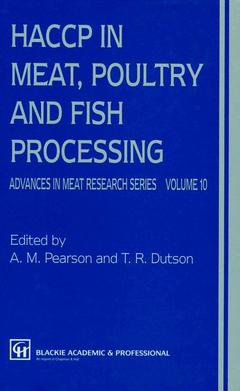HACCP in Meat, Poultry, and Fish Processing, Softcover reprint of the original 1st ed. 1995 Advances in Meat Research Series, Vol. 10
Langue : Anglais

The RACCP (hazard analysis critical control point) concept for food products was an outgrowth of the US space program with the demand for a safe food supply for manned space flights by the National Aeronautics and Space Administration (NASA). The original work was carried out by the Pillsbury Company under the direction of Roward E. Bauman, who as the author of chapter 1 describes the evolution of the RACCP system and its adaptation to foods. The second chapter discusses the adoption of RACCP principles and explains how they fit into the USDA and FDA meat, poultry and seafood inspection systems. The next chapter discusses how RACCP principles can be extended to production of meat, poultry and seafoods, a most important area involved in producing a safe food supply. Chapter 4 deals with the use of RACCP in controlling hazards encountered in slaughtering and distribution of fresh meat and poultry, while chapter 5 discusses the problem - both spoilage and hazards - involved in processing and distribution of meat, poultry and seafood products. Chapter 6 covers the entire area of fish and seafoods, including both fresh and processed products from the standpoints of spoilage and hazards.
1 The origin and concept of HACCP.- 1.1 Introduction.- 1.2 Development of the HACCP concept.- 1.3 Acceptance of HACCP by the food industry.- 1.4 Summary.- References.- 2 The HACCP system and how it fits into FSIS programs.- 2.1 Introduction.- 2.2 HACCP study.- 2.3 Critical control points for various models.- 2.4 In-plant testing of HACCP models.- 2.5 Evaluation.- 2.6 Current HACCP issues.- 2.7 Quadrilateral discussions on food safety.- 2.8 Summary.- References.- 3 Implementation of HACCP program on farms and ranches.- 3.1 Introduction.- 3.2 Livestock quality assurance programs.- 3.3 Implementing HACCP on livestock units.- 3.4 Conclusion.- References.- 4 Implementation of the HACCP program by meat and poultry slaughterers.- 4.1 Introduction.- 4.2 Purpose of HACCP.- 4.3 Development of the HACCP program.- 4.4 Implementation of the HACCP program.- 4.5 Summary.- References.- 5 The use of HACCP for producing and distributing processed meat and poultry products.- 5.1 Introduction.- 5.2 Reasons for using HACCP.- 5.3 Developing HACCP plans.- 5.4 Hazard analysis and risk assessment.- 5.5 Critical control points and critical limits.- 5.6 Monitoring.- 5.7 Corrective action.- 5.8 Record keeping.- 5.9 Verification.- 5.10 Should HACCP be mandatory?.- 5.11 Summary.- References.- Addendum — Guideline for writing operating instructions/HACCP plans for processed meat and poultry products.- 6 Implementation of the HACCP program by the fresh and processed seafood industry.- 6.1 Introduction.- 6.2 Significance of the seafood industry.- 6.3 HACCP in the seafood industry.- 6.4 HACCP and seafood safety.- 6.6 NMFS HACCP program.- 6.7 FDA’s HACCP program.- 6.8 Impact of FDA’s proposed HACCP regulation — an example.- 6.9 Summary.- References.- 7 Risk analysis, HACCP and microbial criteriain meat and poultry systems.- 7.1 Introduction.- 7.2 Risk analysis.- 7.3 How risk analysis and HACCP contribute to food safety.- 7.5 The role of microbiological criteria.- 7.6 Statistical process control.- 7.7 Summary.- Acknowledgements.- References.- 8 Relationship of the HACCP system to Total Quality Management.- 8.1 The importance of quality.- 8.2 Total Quality Management (TQM): the key to continuous quality improvement.- 8.3 The Hazard Analysis Critical Control Point (HACCP) system.- 8.4 Modern quality management: striving for continuous quality improvement.- 8.5 The economics of quality.- 8.6 Implementation of TQM and HACCP.- 8.7 ISO 9000.- 8.8 The National Quality Award.- 8.9 Summary.- Acknowledgements.- References.- 9 HACCP for delicatessens and meat, poultry and seafood retailers.- 9.1 Introduction.- 9.2 Potential hazards.- 9.3 Hazard controls.- 9.4 Monitoring.- 9.5 Corrective actions.- 9.6 Records.- 9.7 Verification.- 9.8 A deli HACCP plan.- 9.9 Example HACCP plans.- 9.10 Summary.- References.- 10 HACCP-TQM for retail and food service operations.- 10.1 Introduction.- 10.2 What is quality?.- 10.3 HACCP principles for food production.- 10.4 Food science HACCP principles.- 10.5 The HACCP-based TQM process.- 10.6 Food operations hazard analysis.- 10.7 Summary.- References.- 11 The HACCP program and the consumer.- 11.1 Introduction.- 11.2 The HACCP program.- 11.3 HACCP and consumers.- 11.4 HACCP incorporation into everyday life.- 11.5 Application of HACCP principles for consumers.- 11.6 Conclusions.- References.- 12 Organization and management of HACCP programs.- 12.1 Introduction.- 12.2 Documentation of HACCP systems.- 12.3 Phases of HACCP system implementation and management requirements.- 12.4 Producing the framework/structure to ensure that the HACCP program isa success.- 12.5 Summary.- References.- 13 Predictive microbiology and HACCP.- 13.1 Introduction.- 13.2 Predictive microbiology.- 13.3 Predictive modelling and and HACCP.- 13.4 Examples of the application of predictive models in HACCP systems.- 13.5 Conclusions.- References.- 14 National and international cooperation on governmental regulations for meat, poultry and fish inspection.- 14.1 Overview.- 14.2 Agencies and functions.- 14.3 Domestic interests and cooperation.- 14.4 International interests and cooperation.- 14.5 Opportunities to increase cooperation.- 14.6 Summary.- References.
Date de parution : 03-2013
Ouvrage de 393 p.
15.5x23.5 cm
Mots-clés :
HACCP; adaptation; adoption; controlling; distribution; evolution; food safety; growth; production; science
© 2024 LAVOISIER S.A.S.



